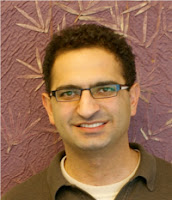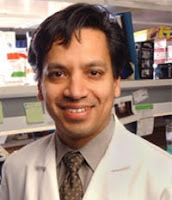The human brain is the most complex structure in the body. It consists of about 100 billion neurons that make around 100 trillion synapses. These connections are constantly changing and the brain must maintain a stable level of electrical activity as it changes. If this balance is disrupted, conditions like epilepsy and schizophrenia can arise. How neurons achieve this feat is still a scientific mystery.
Our guest this month is Dr. Graeme Davis, professor in the department of biophysics at UC San Francisco. Dr. Davis hopes to solve the question of how the brain remains stable as it changes. His lab uses fly genetics to determine important genes involved in maintaining stable neural activity. Listen as Dr. Davis describes how one of these genes, dysbindin, is involved in stabilizing neural function and may have important implications in schizophrenia.
December 01, 2012
October 31, 2012
Energy balance in a changing environment: Kaveh Ashrafi
The ability to maintain energy balance in a changing environment is essential for survival. The brain helps maintain this balance by sending signals that regulate food intake as well as fat storage. Abnormal metabolism has been associated with cardiovascular disease, type II diabetes, and even some neurodegenerative disease. However, the biology behind this link is not completely understood.
Our guest this month, Dr. Kaveh Ashrafi, an associate professor in the department of physiology at UCSF, hopes to tackle this important question. His lab uses microscopic nematodes to understand the genes and neural circuits that control fat and feeding regulation. By taking advantage of the simplicity of the nematode nervous system, scientists in Dr. Ashrafi’s lab can determine the precise role of these genes and how they control feeding behavior. His lab also studies how different chemicals in the environment can regulate metabolism and increase fat levels.
More on the Ashrafi Lab's research
Hosted by Karuna Meda
Our guest this month, Dr. Kaveh Ashrafi, an associate professor in the department of physiology at UCSF, hopes to tackle this important question. His lab uses microscopic nematodes to understand the genes and neural circuits that control fat and feeding regulation. By taking advantage of the simplicity of the nematode nervous system, scientists in Dr. Ashrafi’s lab can determine the precise role of these genes and how they control feeding behavior. His lab also studies how different chemicals in the environment can regulate metabolism and increase fat levels.
More on the Ashrafi Lab's research
Hosted by Karuna Meda
September 30, 2012
The neighborhood of cells in breast cancer: Zena Werb
University of California - San Francisco
Sept. 30, 2012 (Hosted by Karuna Meda)
Breast cancer affects one in eight women and is the seventh leading cause of death for women. Susceptibility to breast cancer is increased around the time of puberty when the breasts develop. More research into how the breasts normally develop and what causes normal cells to become cancer cells is still needed.
Our guest this month is Zena Werb, a professor of anatomy at the UCSF Family Comprehensive Cancer Center. Dr. Werb’s lab studies how a normal cell develops and the role of the cell’s “neighborhood”, the surrounding tissue that is necessary for support and proper development. Looking at how these cells interact in their microenvironment is important for understanding cancer metastasis and may potentially lead to treatments for this disease.
More on the Werb Lab's research
Sept. 30, 2012 (Hosted by Karuna Meda)
Breast cancer affects one in eight women and is the seventh leading cause of death for women. Susceptibility to breast cancer is increased around the time of puberty when the breasts develop. More research into how the breasts normally develop and what causes normal cells to become cancer cells is still needed.
Our guest this month is Zena Werb, a professor of anatomy at the UCSF Family Comprehensive Cancer Center. Dr. Werb’s lab studies how a normal cell develops and the role of the cell’s “neighborhood”, the surrounding tissue that is necessary for support and proper development. Looking at how these cells interact in their microenvironment is important for understanding cancer metastasis and may potentially lead to treatments for this disease.
More on the Werb Lab's research
September 05, 2012
Treating Chagas' Disease: Jim McKerrow
Our guest this month is Dr. James McKerrow, a professor and chair in experimental pathology at UCSF. Dr. McKerrow and his team work to develop new drugs for neglected tropical diseases; diseases that affect low-income regions and consequently receive less attention from pharmaceutical companies. Dr. McKerrow takes us through the process of developing new treatments against these devastating infections.
More on the McKerrow Lab's research
Hosted by Alex Mendelsohn
More on the McKerrow Lab's research
Hosted by Alex Mendelsohn
July 31, 2012
How the brain responds to pheromones: Lisa Stowers
Our brains are responsible for helping us understand and move around in the world. What we perceive through our senses is transformed into electrical activity in our brains, and that activity determines how we act and respond to the environment. Yet, scientists are unclear about how brain cells carry out this transformation.
Our guest this month is Dr. Lisa Stowers from the Scripps Research Institute. Her lab uses mice to study how chemical signals known as pheromones activate particular groups of neurons, and how this activity produces instinctive behaviors of fear, attraction, and aggression. By studying this system, Dr. Stowers hopes to shed new light on how the brain processes senses and generates behavior.
More on the Stowers Lab's research
Producer: Sama Ahmed
Our guest this month is Dr. Lisa Stowers from the Scripps Research Institute. Her lab uses mice to study how chemical signals known as pheromones activate particular groups of neurons, and how this activity produces instinctive behaviors of fear, attraction, and aggression. By studying this system, Dr. Stowers hopes to shed new light on how the brain processes senses and generates behavior.
More on the Stowers Lab's research
Producer: Sama Ahmed
June 30, 2012
The Social Worm: Cori Bargmann
What controls the way we behave? Our guest this week, Dr. Cornelia Bargmann, hopes to answer this complicated question. She explains how our biology, our genes, and the environment we live in can affect the way we behave. She is especially interested in understanding social behaviors, or how animals interact with each other. In her research, she uses the humble worm, known as c. elegans, to study the underlying biology that can switch an individual from being a loner to a party animal, and vice versa.
Cori is a professor at The Rockefeller University and an investigator of the Howard Hughes Medical Institute. She has recently been featured in the Charlie Rose Brain Series and The New York Times.
For an additional teaching resource, check out the lesson plan we created to accompany this episode.
More on the Bargmann Lab's research
Hosted by Osama Ahmed
Cori is a professor at The Rockefeller University and an investigator of the Howard Hughes Medical Institute. She has recently been featured in the Charlie Rose Brain Series and The New York Times.
For an additional teaching resource, check out the lesson plan we created to accompany this episode.
More on the Bargmann Lab's research
Hosted by Osama Ahmed
June 03, 2012
Regenerating the heart: Deepak Srivastava
Heart disease is the number one cause of death in men and women, and congenital heart defects affect about 1 out of every 100 babies worldwide. Our guest, Dr. Deepak Srivastava, a professor of pediatrics and the director of the Gladstone Institute of Cardiovascular Disease at UCSF, is focused on changing that statistic.
By studying how stem cells in the developing embryo transform into heart cells, Dr. Srivastava hopes to find out what causes children to be born with heart abnormalities. Additionally, by understanding how nature develops healthy heart cells, research in the Srivastava lab may soon lead to new therapies for patients with heart disease. His lab has already found a way to guide non-muscle cells in the heart into fully functional, beating muscle cells in mice. He hopes to move these strategies into clinical human studies in the future.
At the end of our talk, Dr. Srivastava gives his most important advice for an aspiring, young scientist.
More on the Srivastava Lab's research
Hosted by Karuna Meda
By studying how stem cells in the developing embryo transform into heart cells, Dr. Srivastava hopes to find out what causes children to be born with heart abnormalities. Additionally, by understanding how nature develops healthy heart cells, research in the Srivastava lab may soon lead to new therapies for patients with heart disease. His lab has already found a way to guide non-muscle cells in the heart into fully functional, beating muscle cells in mice. He hopes to move these strategies into clinical human studies in the future.
At the end of our talk, Dr. Srivastava gives his most important advice for an aspiring, young scientist.
More on the Srivastava Lab's research
Hosted by Karuna Meda
April 30, 2012
Stem cells and epigenetics: Barbara Panning
The developing embryo is made up of special cells called stem cells. Unlike most cells, stem cells have the unique ability to transform into specialized adult cells, such as those that make up our heart or the neurons in our brain. In the last five years, scientists have designed a method to go backwards; now the specialized adult cells can be turned into embryonic stem cells. However, a lot of questions remain unanswered. For instance, scientists still do not completely understand what triggers stem cells to transform into different cell types. Or what process keeps stem cells from changing in the first place.
Our guest, Dr. Barbara Panning, a professor in the department of biochemistry at UCSF, is in the process of answering this question. Using a process called RNA interference, her lab turns off specific genes one by one to see how embryonic stem cells are affected. Her research has potentially important implications for diseases like breast cancer.
More on the Panning Lab's research
Hosted by Sama Ahmed
Our guest, Dr. Barbara Panning, a professor in the department of biochemistry at UCSF, is in the process of answering this question. Using a process called RNA interference, her lab turns off specific genes one by one to see how embryonic stem cells are affected. Her research has potentially important implications for diseases like breast cancer.
More on the Panning Lab's research
Hosted by Sama Ahmed
Subscribe to:
Comments (Atom)







